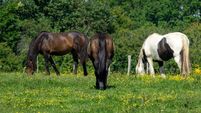Oliver Moore: Optimising health of organic livestock

Teagasc’s 2016 publication ‘Organic Demonstration Farm Walk’ for the March 10 walk on John Purcell’s farm can be found under ‘events’ on the Teagasc website. And the Irish Organic Farmers and Growers Association’s 2015 ‘Beef and Diary Livestock’ document is downloadable from its website’s news section.
Much is covered in both, and I highlight some animal healths tips here.













